Alternative energy source for diesel engine in tractor, how do you like that?

The diesel engine is increasingly under discussion. Manufacturers are working on alternative energy sources. Martin Smits talked with some users who are gaining experience with tractors that use little or no diesel anymore.
For many it is as clear as day; it may take some time, but in the future agricultural tractors will also increasingly run on an energy source other than fossil fuel, such as a diesel engine. The trend has been set, but the sequel is a chicken-and-egg story.
On the one hand, an alternative must be available, on the other hand, developing it is only interesting if there is demand. The time of looking at each other and waiting for each other is now over. Some manufacturers and the first users are taking clear steps to drive tractors with less CO2 emissions or even completely fossil-free.
We spoke with users of four different systems:
- The all-electric 700 Vario Electric ; the Fendt 700 tractor converted by Agromec together with Electric Construction Equipment in Veghel, The Netherlands.
- The New Holland T6.180 on methane gas , which New Holland supplies from the factory.
- The T5.140 of the same brand on hydrogen that the manufacturer is marketing in collaboration with Scholman in Nieuwegein, The Netherlands.
- An experience in Canada with the Monarch MK-V.
Initiate development of alternative fuel
The users of the first hour are unanimously satisfied with the technical functioning of their tractor on an alternative fuel. We also note that the experiences are still fairly recent, a maximum of one year. However, it supports confidence in the technique they have chosen.
The motivation they mention: wanting to take a step to initiate a development that is inevitable for the future, and being prepared to invest in it. They realize that the technology in its current form is not the final solution, but it is an important step.
Each system has its advantages and disadvantages. It does not seem unlikely that several systems will succeed in the future, each suited to a specific situation. Technically there is still a lot to develop and improve. There is also still some way to go in terms of legislation – concerning storage, transport or self-generation of hydrogen.
Agromec with 2.000 kg heavy battery in front linkage
Contractor company Van Wijlen in Sprang-Capelle (N.-Br.), The Netherlands, is the first user of a fully electrically driven Agromec 700 Vario Electric. The electric motor in this ‘electric Fendt’ delivers about 200 hp (150 kWh). The company mainly uses the tractor with a ground dumper in infrastructure and agricultural engineering. “Since 2015, we have been participating in the CO2 performance ladder of the Foundation for Climate Friendly Procurement and Entrepreneurship”, says director Bart van Wijlen.
Text continues below video
Van Wijlen wants to contribute to a world that is less dependent on fossil fuels. In 2014, Van Wijlen moved into new premises. Not connected to the gas, but with a heat pump and solar panels on the roof. There are now a few electric passenger cars and six on hydrogen. Two of the ten shovels are electric and one of the twenty tractors is the fully electrically powered 700. It works well.
Compared to the same tractor with a full diesel tank, the electric one lasts less time. A 15-tonne battery would be required for the same energy content as a full diesel tank. The tractor itself has a 70 kWh battery on board, but most of the energy is supplied by a 2,000 kilo battery in the front linkage. At full power, for a heavy cultivator or spading combination, you can drain the battery in one or two hours. In practice, however, the tractor can easily run a normal working day with two battery charges.
Qualified driver drives Agromec
Jan van der Zwaan in Oostrum (L.) has been running the same Agromec for a few months. They mostly use an earth dumper, a water truck or a road plate truck in road and hydraulic engineering. Van der Zwaan uses his tractor for work at contractor Ploegam. He took four of these tractors into use, for which Van der Zwaan supplies the drivers. “Driving a 700 Vario Electric is no different than driving a diesel 700 series. But because you work with an 800-volt system, safety is a point,” says Van der Zwaan.
Van der Zwaan does not just send every driver out with this tractor. Think of it like a cordless drill. When the battery is empty, you have to change and you can continue. Disconnecting and connecting the battery is a matter of minutes with the quick-connect system. But you must have knowledge of it to do so responsibly. Such a tractor has cost serious money, so you want to have a qualified driver on it.
Read more below the picture
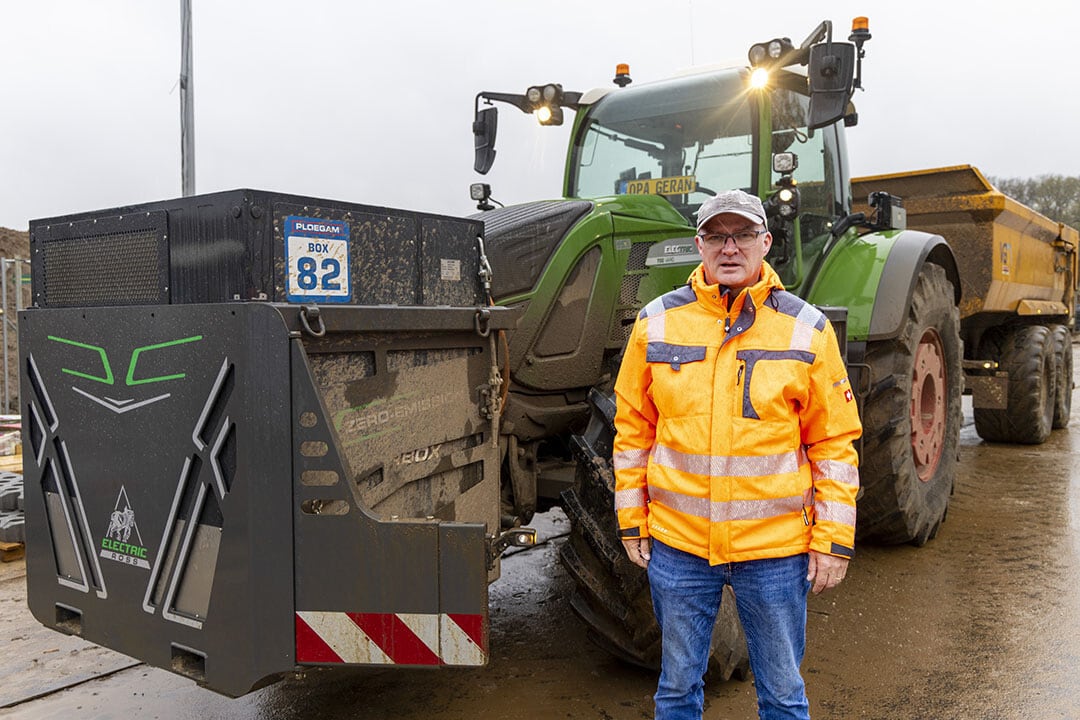
Charging batteries
Apart from a few small things in the very beginning, the tractor is technically fine. A condition for efficient use is that the infrastructure for charging batteries is in good order. Count on 3 hours of charging time, although there are also systems to do that within 1 hour. In normal work where the tractor is not running full load all day, you have to change the battery at least once a day. Another point is the additional cost of the investment. Agromec gives an indication of € 500,000 for the tractor.
Van der Zwaan also does contract work in agriculture. An electric tractor would also fit there, but he cannot charge customers extra for it now. Speaking of agricultural work: with a 2-tonne battery in the front, no tool will fit. Stefan Spits, work planner at Ploegam, confirms the experiences of Van der Zwaan and Van Wijlen. “The Dutch governmental organization Rijkswaterstaat is making more and more demands on sustainability. That is why we have taken up the gauntlet. We started developing electrical machines in-house: crawler cranes, mobile crane, mini-excavator, tractor, and soon a 50 ton crawler crane. The tractors are eligible for subsidy. That makes the investment attractive. Without a subsidy, a more versatile vehicle, such as a truck, is more interesting.
Read more below the picture
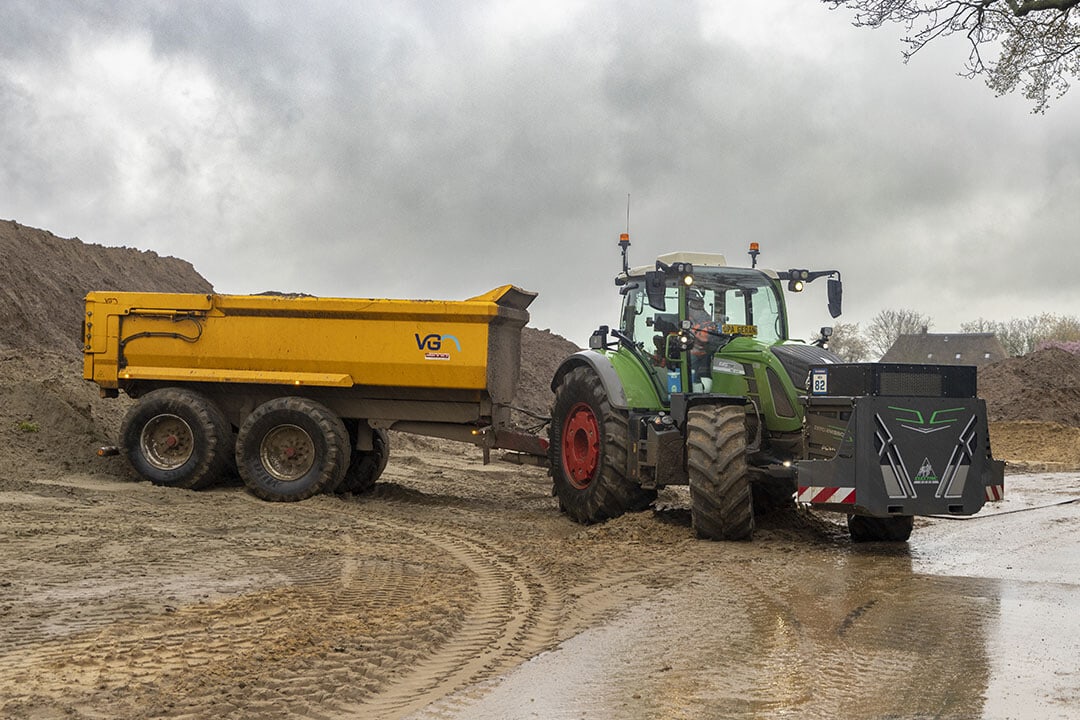
New Holland T6 on methane with extra tank
Marinus and Dick Groenenboom are satisfied with their New Holland T6 on methane gas. Together with their father Martin they run the K. Groenenboom contractor company in Barendrecht (Z.-H.), The Netherlands. The methane gas tractor mainly works on sports fields. Technically it has been functioning flawlessly since June last year. Just as reliable as a diesel.
Technically it has been functioning flawlessly since June last year
The methane tractor runs on bio-CNG, which they fill up at OG Clean Fuels. It is biogas from a sewage treatment plant; virtually no CO2, nitrogen, particulate matter and NOx are released in the entire production chain. The gas station is close by and the truck still passes by every day, so it works fine. Delivery in containers on location is also possible if desired.
Read more below the picture
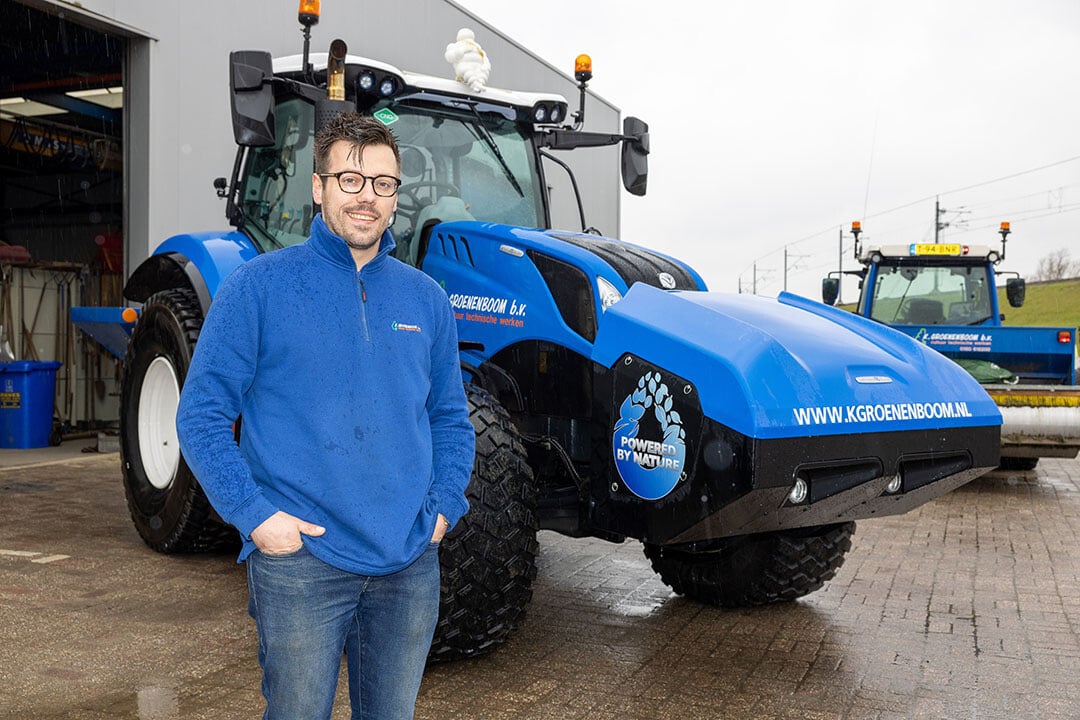
Before the Groenenbooms took the step, they first had a methane T6 on trial next to the same diesel tractor. It soon became clear that the fuel costs are almost the same for the same job. They did find the standard New Holland tank too small. That is why they had an extra tank installed on the side at their own expense.
With varied work, their tractor lasts 8 to 12 hours on a full load, says Marinus. Very handy, because the methane tractor – unlike a hydrogen gas one – cannot continue on diesel. If the T6 were to run full load all day, an 8-hour working day would not be feasible. Partly because of this, he deliberately didn’t get a crawler.
Furthermore, the front tank is a drawback that hinders a wide range of uses. It is needed to have enough fuel on board, but the front linkage is omitted. A concession they made in order to take a step forward. The technology is practical. There are still no teething problems and the maintenance is the same as a diesel engine.
The best of three worlds
Groenenboom motivates the choice for alternative fuel with the desire to emit less CO2. That’s where it’s going anyway. It is becoming increasingly important for governments to be able to indicate in an action plan that you have something to offer in terms of emissions. Although this has not yet forced the purchase of another tractor, the first applications have now been received specifically for the use of the methane gas tractor.
In addition to methane, they also looked at hydrogen. That fuel was dropped for two reasons. Firstly, the engine will still run on fossil fuel for 60%. And a practical point: the tractor regularly goes on the truck for transport. With a hydrogen tank on the roof you are then too high to drive everywhere.
Electric was also an option. Governments are very fond of this, the contractor knows from experience. But the quote for an electrically powered tractor had an additional cost of € 145,000. Not interesting if there is no opposite project for which you can charge those additional costs. Moreover: although the tractor itself is free of emissions, a lot of electricity production is still based on fossil fuels.
The methane gas variant is about € 40,000 cheaper to purchase than a hydrogen tractor, which costs around € 80,000 more than a T6 on diesel. An additional € 40,000 is also serious money, but manageable with a tractor that functions well and with which you have something to offer to significantly reduce emissions, says Groenenboom. Some contractors are already asking specifically about the methane gas tractor in order to carry out projects with the lowest possible emissions.
Read more below the picture

New Holland T5 on hydrogen
Transport company Kloosterman in Kapelle Biezelinge (Zld.), The Netherlands, has been working with a hydrogen-powered New Holland T5.140 since June last year. Cousins Carlo and Jan Kees Kloosterman, driving forces behind the more than 100-year-old family business, foresee that in the future it will move towards less or no emissions at all from tractors and machines. With our purchase we are a little ahead of that, says Carlo. “To gain experience and not to follow developments. For our tenders, the search for another energy source was a trigger. In the future it will become more important that we can respond to environmental issues. Electricity is now very interesting for small machines, but we think it is still far too expensive for large machines. Can you CO2-neutral generation of electricity, then you can also produce CO2-neutral hydrogen. And we see that as one of the directions for the future.”
The T5 is a modified diesel that mixes hydrogen. On average, 40 to 45% of the fuel is hydrogen, the rest is diesel. According to calculations, if you fill up with fossil diesel, this could already result in a 65% reduction in CO2 emissions.
Read more below the picture
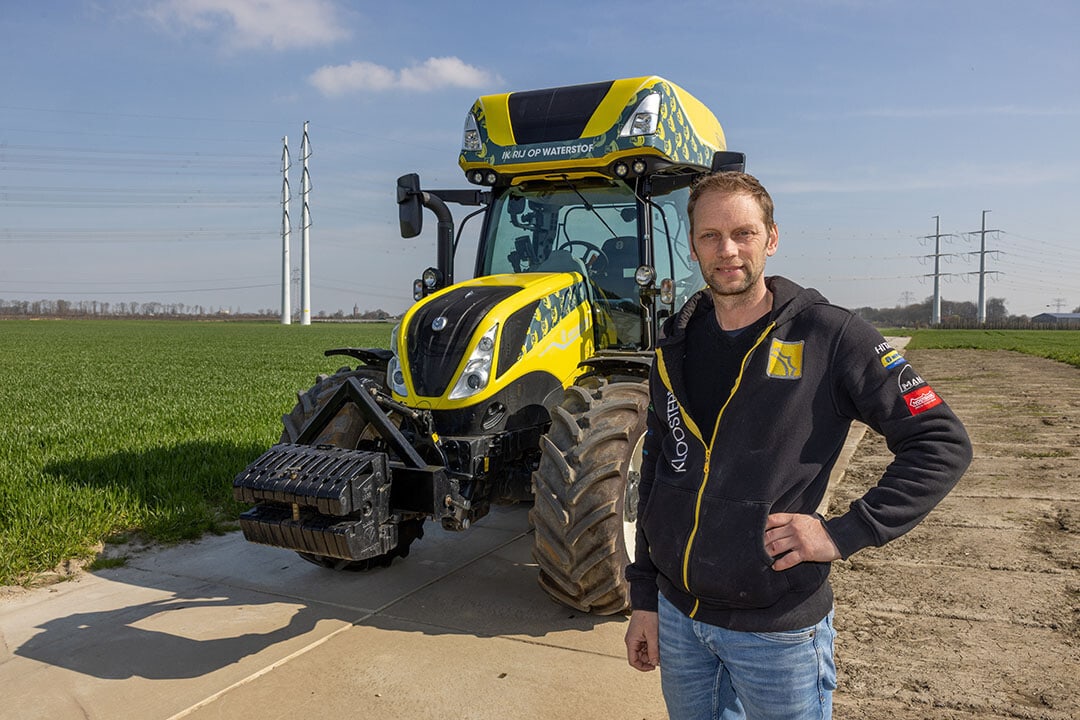
Lot of attention
The tractor gets a lot of attention at fairs in the area. He now has about 400 hours on the clock. Technically the machine functions without any problems. The tanks on the roof can hold up to 5 kilos of hydrogen. 1 kilo has the energy content of 8 liters of diesel. An 8-hour working day with normal work requires around 4 kilos. When the hydrogen is gone, the tractor can continue on diesel.
An additional practical advantage of the hydrogen tractor is that it can still handle a front linkage. Kloosterman also uses it for small jobs such as sweeping or sliding. Most of the time, however, the tractor is in front of a ground tipper.
Read more below the picture
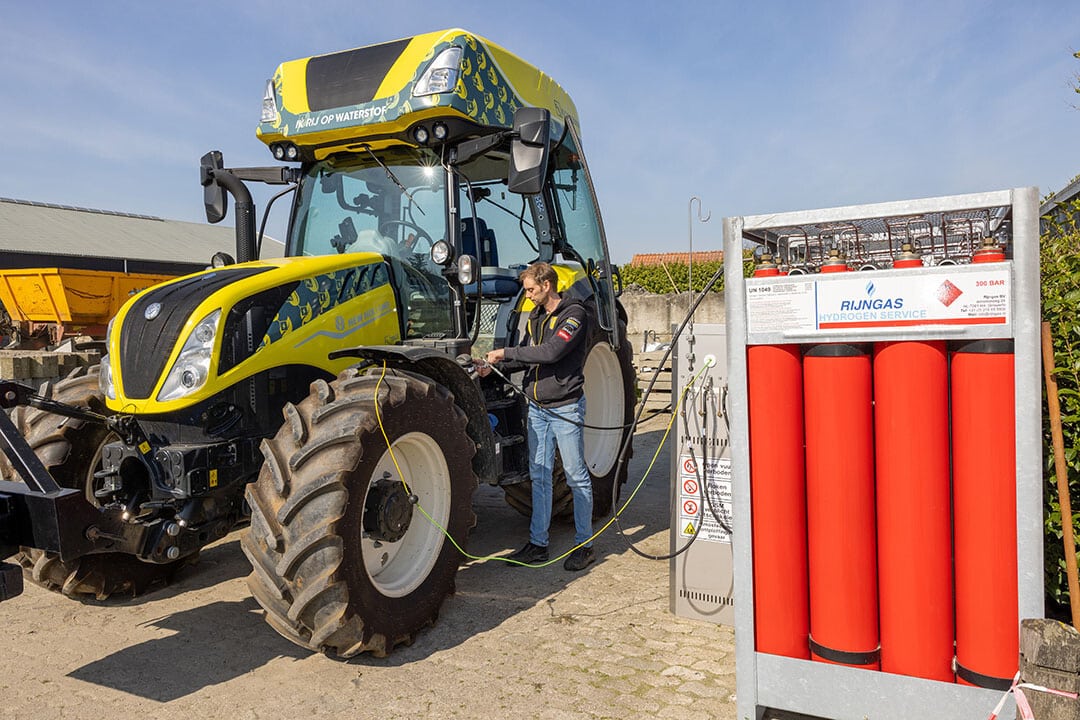
Hydrogen is an expensive fuel
The only thing that was disappointing is the price of hydrogen. It started last summer at around € 14 per kilo. Converted, that was then still a bit around the price level of diesel. There is now € 25 per kilo on the bill.
The company is looking at possibilities to produce hydrogen with its own solar panels. In addition to the investment, this will also involve a lengthy process of obtaining permits. On the other hand, the supply of hydrogen may change. In the Sloe area, near Vlissingen, a large hydrogen plant will be built that will convert electricity from the North Sea into hydrogen. This will probably not be the last development in the field of hydrogen. Together with the municipality of Kapelle and CZAV, Kloosterman is investigating the possibilities of an H2 hub with green hydrogen.



